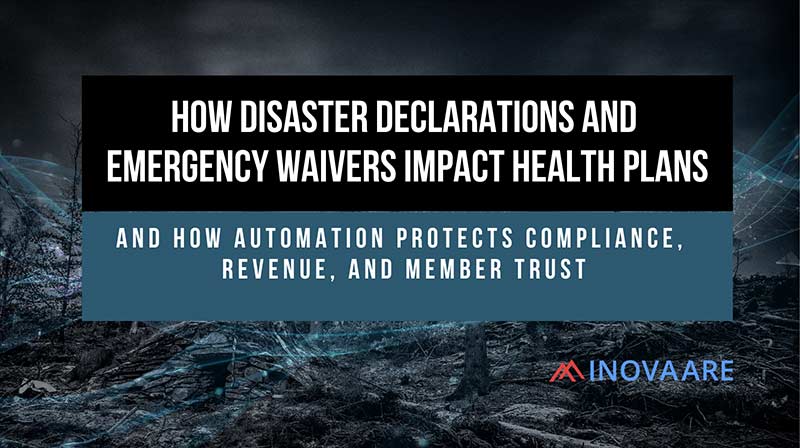How automation protects compliance, revenue, and member trust
For health plans, disasters don’t just test emergency response; they test compliance, operations, and trust. When a disaster strikes, whether it is a hurricane, wildfire, or pandemic, CMS and state agencies issue disaster declarations and emergency guidance waivers that alter how health plans must operate. Timelines shift. Prior authorizations are waived. Appeals deadlines extend. Member communications change. For payers, these directives impact compliance, operations, and the bottom line.
History shows the stakes. During the COVID-19 pandemic, CMS issued over 200 emergency 1135 waivers, covering a range of issues, including telehealth expansion and network adequacy requirements. Following Hurricane Ian in 2022, several emergency waivers were issued by federal and state agencies to support disaster recovery efforts, including waivers from the CMS.
In both cases, health plans that failed to operationalize changes quickly faced audit scrutiny, corrective action plans (CAPs), and revenue exposure in millions.
Emergency response management is not an academic exercise for payers. A delayed response can mean audit findings, multimillion-dollar corrective action plans, and a drop in Star ratings that wipes out tens of millions in revenue. More importantly, it can mean members in crisis lose timely access to care, eroding trust when it matters most.
The impact of disaster declarations on payers
When a waiver drops, three areas of risk hit health plans hard:
- Compliance risk: Timelines reset, requirements shift, and regulators demand evidence that changes were implemented in a timely manner.
- Financial exposure: Improper payments tied to operational lapses totaled $31.7B in 2023; CAPs can cost $1M–2M each, and a one-star drop may wipe out $50M–$100M in revenue.
- Member trust: In the event of a disaster, any delay in access to care is amplified, directly impacting satisfaction and Stars scores.
Manual response to disaster declarations is no longer enough
For most payers, waiver management remains a manual process. Compliance teams forward emails. Policy updates are typically maintained in spreadsheets or Word documents. Operations leaders scramble to interpret guidance and push updates across multiple systems. Member services often hear about changes last.
This fragmented approach creates predictable breakdowns:
- Guidance gets missed or misinterpreted. Disaster notices are often lengthy, technical, and buried among routine updates. Without automation, teams rely on manual review, increasing the risk of overlooking critical waivers or applying them incorrectly.
- Rules are applied inconsistently. One department adjusts its claims processing while another continues to use pre-disaster requirements. The result is inconsistent decisions that invite audit findings and member disputes.
- Audit logs are incomplete. Regulators don’t just ask if you complied, they ask when and how. Manual tracking rarely provides defensible, time-stamped evidence, leaving compliance officers exposed.
- Member services lag. By the time call centers or provider relations teams are briefed, members may already be frustrated by denials or delays. This drives up complaints, depresses CAHPS scores, and ultimately threatens Stars ratings.
In short, manual processes turn emergency flexibility into long-term liability. What CMS intended as relief for members and providers too often becomes a compliance trap for payers still running on outdated, paper-and-spreadsheet-based workflows.
What automation looks like instead
With an automated system for managing disaster declarations, the same scenario unfolds very differently:
- Waivers are captured instantly. CMS, FEMA, and state guidance flow directly into a central compliance library.
- AI-powered impact summaries are available instantly. Complex notices are distilled into clear, actionable guidance for compliance, operations, and member services.
- Tasks are mapped and tracked. Rules are assigned to the right teams, with deadlines and escalations built in.
- Audit trails are built automatically. Every change is time-stamped and documented, creating defensible evidence for regulators.
- Members and providers are informed faster. Automated updates ensure that service teams and portals communicate the right rules, in real-time, to those who need them most.
- Cross-team orchestration. Assignments, deadlines, and escalations ensure no waiver slips through the cracks.
The result is consistency, speed, and audit-readiness, turning a regulatory disruption into a moment to demonstrate resilience and protect member trust.
How Inovaare transforms waiver management
For most payers, disaster declarations feel like an unwelcome fire drill, scrambling people, processes, and systems. However, with Inovaare’s Disaster Declaration Library, part of the Regulatory Compliance Management platform, payers can turn it into an opportunity to demonstrate readiness, strengthen trust, and protect their bottom line.
When CMS issues a waiver, the Disaster Declaration Library software doesn’t just capture it; it translates regulatory complexity into clear actions across the enterprise. Compliance teams know exactly what changed. Operations leaders identify where processes need to shift. Member services get the right talking points before calls even come in. Executives gain real-time visibility into risks and response timelines.
The value compounds quickly:
- Fewer audit findings are logged because every waiver is logged, tracked, and documented.
- Revenue protection by avoiding costly CAPs and safeguarding Stars ratings.
- Operational efficiency is achieved as automation reduces the manual burden on staff.
- Member trust is maintained because coverage adjustments are implemented and communicated without delay.
Why every health plan needs emergency guidance automation
CMS has made it clear: disasters and emergencies will no longer be excuses for compliance gaps. With annual audits expanding and waiver volume rising, payers that still rely on manual waiver management are at a competitive and regulatory disadvantage.
Inovaare’s Disaster Declaration Library is purpose-built for health plans, deploys quickly with minimal IT lift, and sits natively on our payer-native Healthcare Cloud Platform, meaning it integrates seamlessly with Appeals & Grievances, Audit, Risk, and AI Agents. The result is a simple, scalable, and future-proof solution that no health plan can afford to delay. The plans that adopt disaster declaration and emergency guidance automation today will be the ones that avoid CAPs, protect Stars, and build member trust when the next disaster hits.
See how Inovaare’s Disaster Declaration Library turns regulatory disruption into resilience. Request a demo.
